Financial Decision Making for GoGo Airlines: Unit 5 & 6
VerifiedAdded on 2023/01/09
|12
|2364
|77
Discussion Board Post
AI Summary
This discussion forum post and journal entry examines the financial decision-making process for GoGo Airlines, focusing on the proposed launch of MegaSaver Airways, a no-frills airline. The student analyzes both qualitative and quantitative factors that the CEO must consider, including direct material and labor costs, interest expenses, employee morale, customer perceptions, and investor thinking. The post emphasizes the importance of strategic management accounting, particularly the use of management information systems, to evaluate data and set cost targets. The balanced scorecard is highlighted as a crucial tool for integrating financial and non-financial metrics, enabling the CEO to assess performance from financial, customer, learning and growth, and internal business process perspectives. The responses to the initial post further explore factors such as salary limitations, supplier negotiations, and the application of techniques like PESTEL analysis and the Likert scale to gather market insights. The journal entry then delves into two specific strategic management accounting techniques: target costing and the balanced scorecard, explaining how they can be applied to help GoGo Airlines succeed with its new venture. References to relevant academic literature are provided throughout.
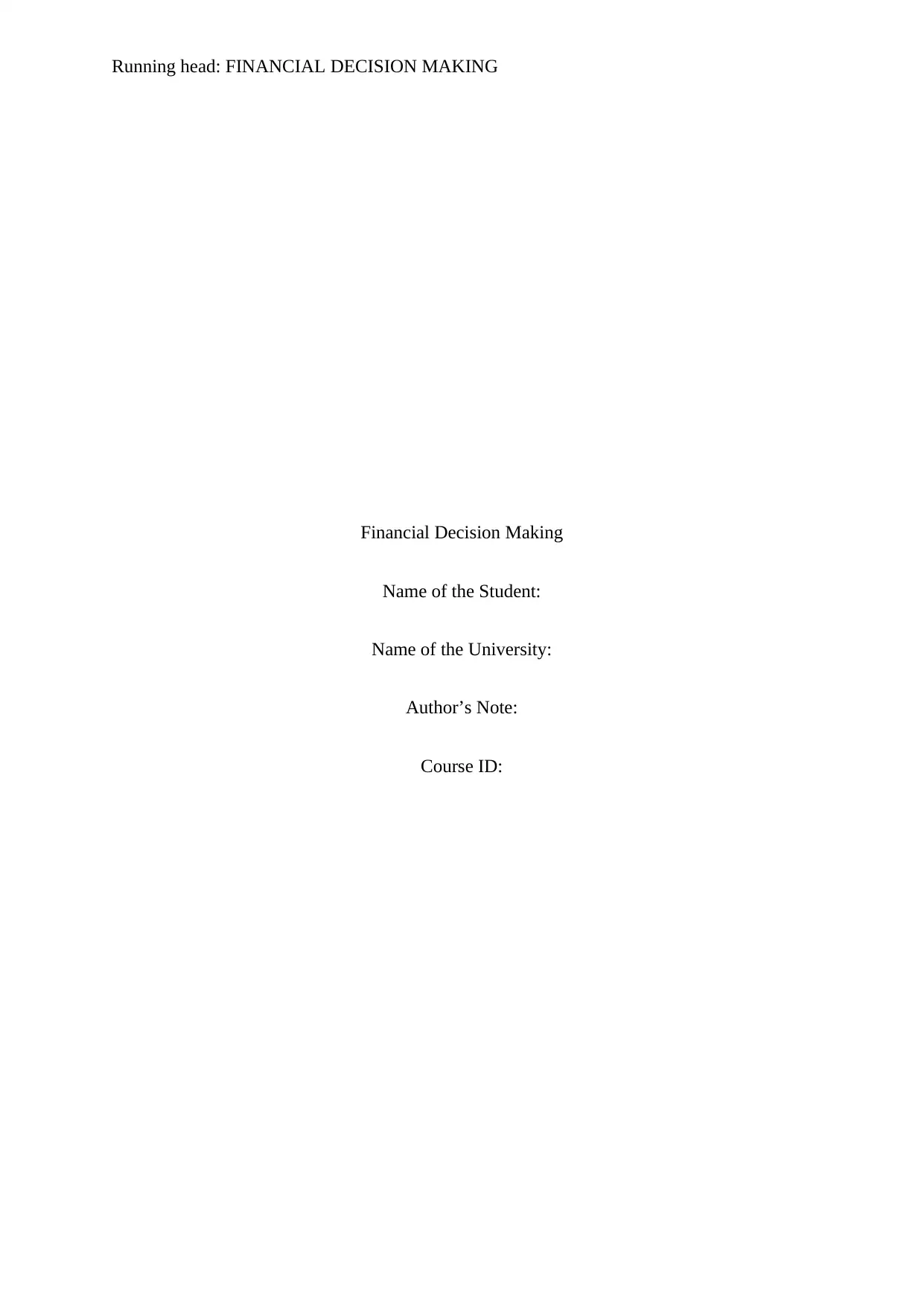
Running head: FINANCIAL DECISION MAKING
Financial Decision Making
Name of the Student:
Name of the University:
Author’s Note:
Course ID:
Financial Decision Making
Name of the Student:
Name of the University:
Author’s Note:
Course ID:
Paraphrase This Document
Need a fresh take? Get an instant paraphrase of this document with our AI Paraphraser
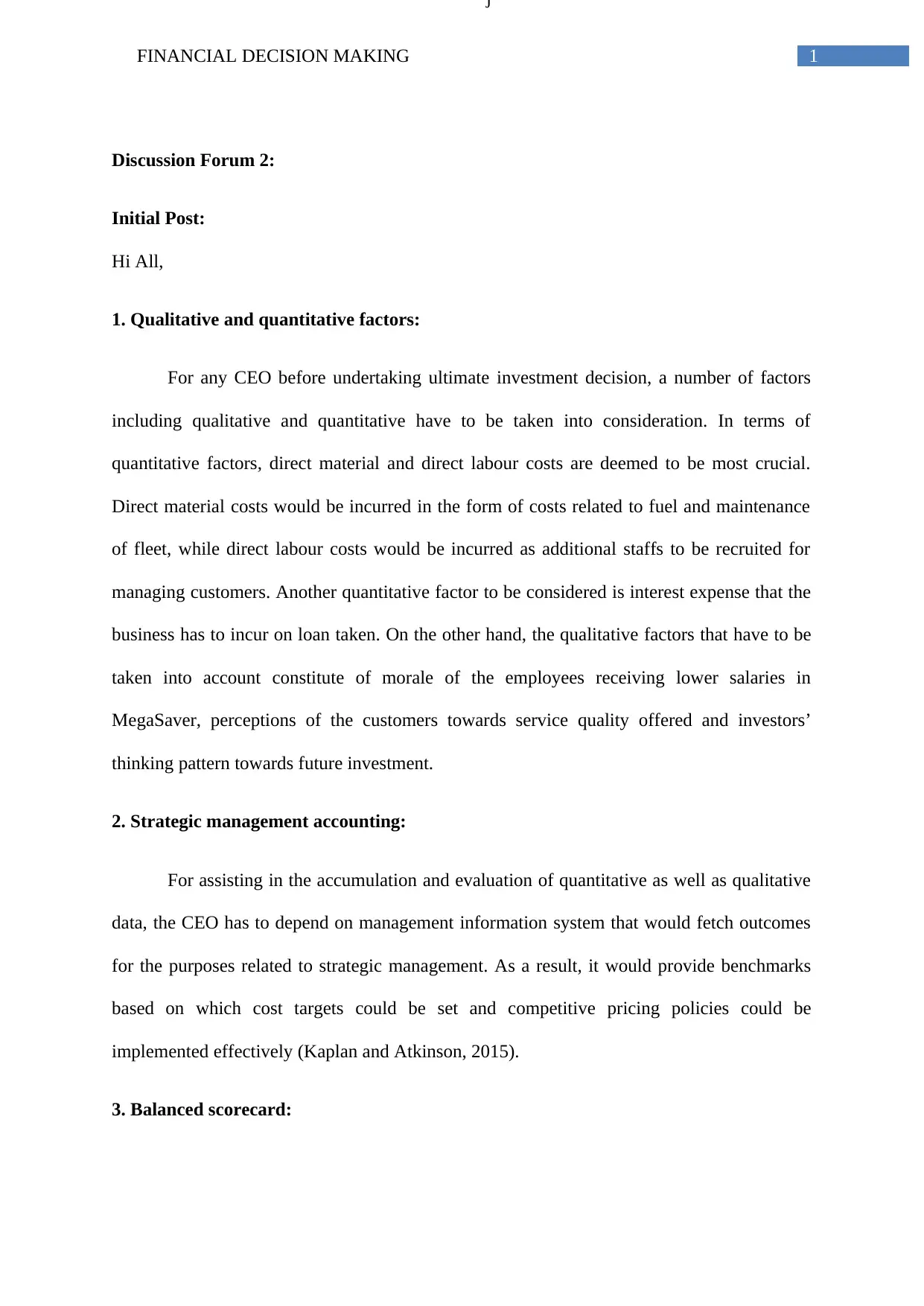
1
j
FINANCIAL DECISION MAKING
Discussion Forum 2:
Initial Post:
Hi All,
1. Qualitative and quantitative factors:
For any CEO before undertaking ultimate investment decision, a number of factors
including qualitative and quantitative have to be taken into consideration. In terms of
quantitative factors, direct material and direct labour costs are deemed to be most crucial.
Direct material costs would be incurred in the form of costs related to fuel and maintenance
of fleet, while direct labour costs would be incurred as additional staffs to be recruited for
managing customers. Another quantitative factor to be considered is interest expense that the
business has to incur on loan taken. On the other hand, the qualitative factors that have to be
taken into account constitute of morale of the employees receiving lower salaries in
MegaSaver, perceptions of the customers towards service quality offered and investors’
thinking pattern towards future investment.
2. Strategic management accounting:
For assisting in the accumulation and evaluation of quantitative as well as qualitative
data, the CEO has to depend on management information system that would fetch outcomes
for the purposes related to strategic management. As a result, it would provide benchmarks
based on which cost targets could be set and competitive pricing policies could be
implemented effectively (Kaplan and Atkinson, 2015).
3. Balanced scorecard:
j
FINANCIAL DECISION MAKING
Discussion Forum 2:
Initial Post:
Hi All,
1. Qualitative and quantitative factors:
For any CEO before undertaking ultimate investment decision, a number of factors
including qualitative and quantitative have to be taken into consideration. In terms of
quantitative factors, direct material and direct labour costs are deemed to be most crucial.
Direct material costs would be incurred in the form of costs related to fuel and maintenance
of fleet, while direct labour costs would be incurred as additional staffs to be recruited for
managing customers. Another quantitative factor to be considered is interest expense that the
business has to incur on loan taken. On the other hand, the qualitative factors that have to be
taken into account constitute of morale of the employees receiving lower salaries in
MegaSaver, perceptions of the customers towards service quality offered and investors’
thinking pattern towards future investment.
2. Strategic management accounting:
For assisting in the accumulation and evaluation of quantitative as well as qualitative
data, the CEO has to depend on management information system that would fetch outcomes
for the purposes related to strategic management. As a result, it would provide benchmarks
based on which cost targets could be set and competitive pricing policies could be
implemented effectively (Kaplan and Atkinson, 2015).
3. Balanced scorecard:
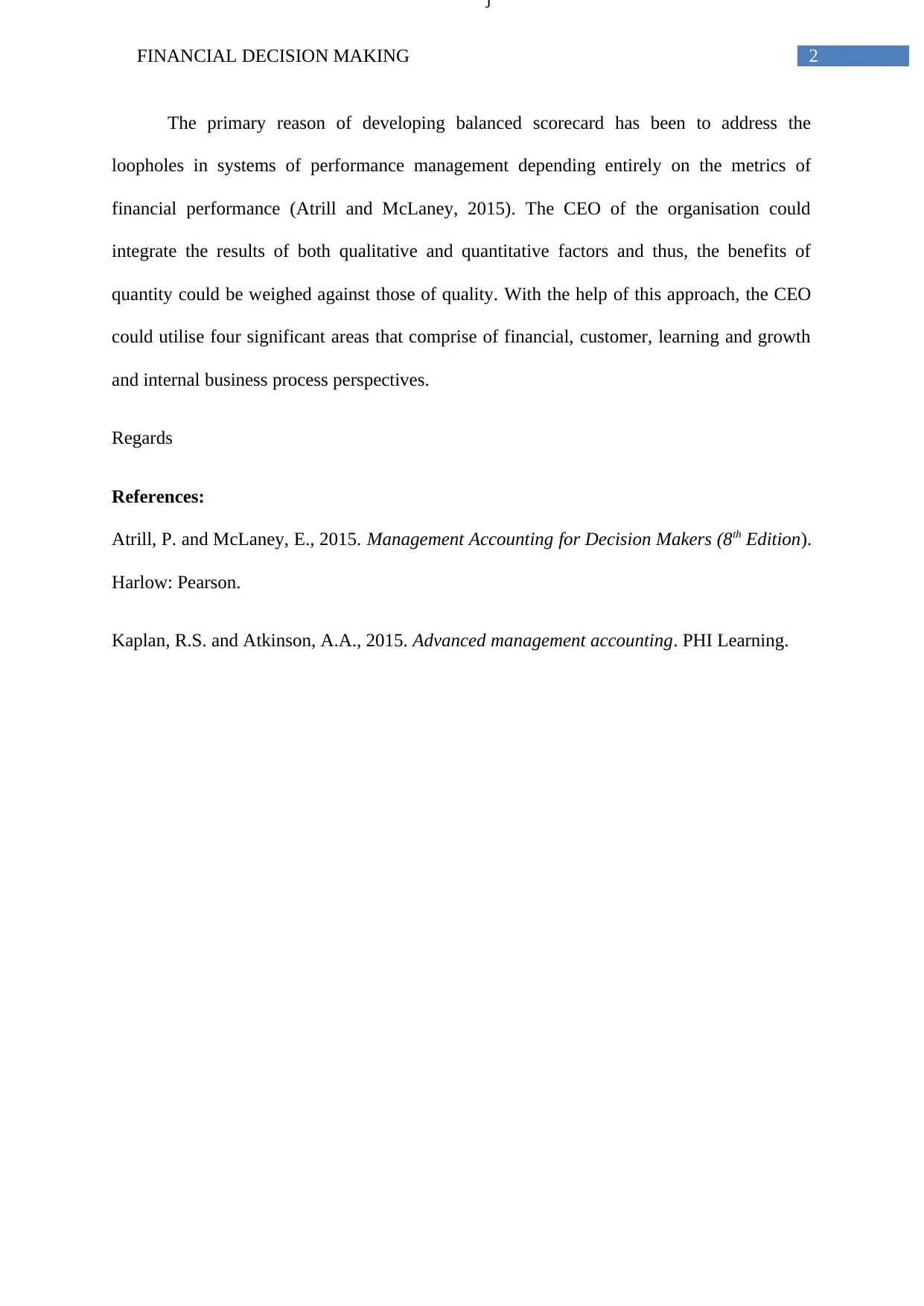
2
j
FINANCIAL DECISION MAKING
The primary reason of developing balanced scorecard has been to address the
loopholes in systems of performance management depending entirely on the metrics of
financial performance (Atrill and McLaney, 2015). The CEO of the organisation could
integrate the results of both qualitative and quantitative factors and thus, the benefits of
quantity could be weighed against those of quality. With the help of this approach, the CEO
could utilise four significant areas that comprise of financial, customer, learning and growth
and internal business process perspectives.
Regards
References:
Atrill, P. and McLaney, E., 2015. Management Accounting for Decision Makers (8th Edition).
Harlow: Pearson.
Kaplan, R.S. and Atkinson, A.A., 2015. Advanced management accounting. PHI Learning.
j
FINANCIAL DECISION MAKING
The primary reason of developing balanced scorecard has been to address the
loopholes in systems of performance management depending entirely on the metrics of
financial performance (Atrill and McLaney, 2015). The CEO of the organisation could
integrate the results of both qualitative and quantitative factors and thus, the benefits of
quantity could be weighed against those of quality. With the help of this approach, the CEO
could utilise four significant areas that comprise of financial, customer, learning and growth
and internal business process perspectives.
Regards
References:
Atrill, P. and McLaney, E., 2015. Management Accounting for Decision Makers (8th Edition).
Harlow: Pearson.
Kaplan, R.S. and Atkinson, A.A., 2015. Advanced management accounting. PHI Learning.
⊘ This is a preview!⊘
Do you want full access?
Subscribe today to unlock all pages.

Trusted by 1+ million students worldwide
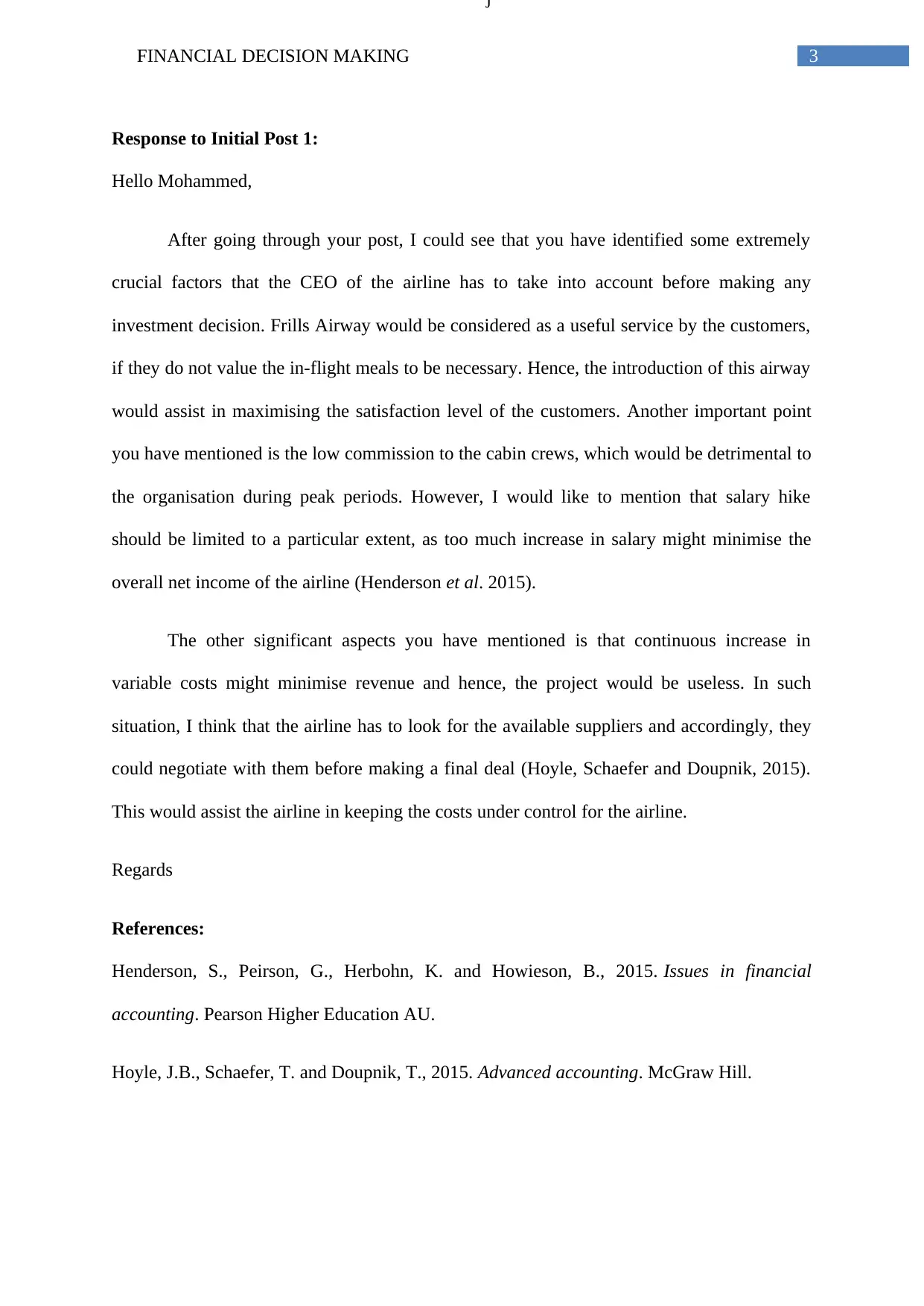
3
j
FINANCIAL DECISION MAKING
Response to Initial Post 1:
Hello Mohammed,
After going through your post, I could see that you have identified some extremely
crucial factors that the CEO of the airline has to take into account before making any
investment decision. Frills Airway would be considered as a useful service by the customers,
if they do not value the in-flight meals to be necessary. Hence, the introduction of this airway
would assist in maximising the satisfaction level of the customers. Another important point
you have mentioned is the low commission to the cabin crews, which would be detrimental to
the organisation during peak periods. However, I would like to mention that salary hike
should be limited to a particular extent, as too much increase in salary might minimise the
overall net income of the airline (Henderson et al. 2015).
The other significant aspects you have mentioned is that continuous increase in
variable costs might minimise revenue and hence, the project would be useless. In such
situation, I think that the airline has to look for the available suppliers and accordingly, they
could negotiate with them before making a final deal (Hoyle, Schaefer and Doupnik, 2015).
This would assist the airline in keeping the costs under control for the airline.
Regards
References:
Henderson, S., Peirson, G., Herbohn, K. and Howieson, B., 2015. Issues in financial
accounting. Pearson Higher Education AU.
Hoyle, J.B., Schaefer, T. and Doupnik, T., 2015. Advanced accounting. McGraw Hill.
j
FINANCIAL DECISION MAKING
Response to Initial Post 1:
Hello Mohammed,
After going through your post, I could see that you have identified some extremely
crucial factors that the CEO of the airline has to take into account before making any
investment decision. Frills Airway would be considered as a useful service by the customers,
if they do not value the in-flight meals to be necessary. Hence, the introduction of this airway
would assist in maximising the satisfaction level of the customers. Another important point
you have mentioned is the low commission to the cabin crews, which would be detrimental to
the organisation during peak periods. However, I would like to mention that salary hike
should be limited to a particular extent, as too much increase in salary might minimise the
overall net income of the airline (Henderson et al. 2015).
The other significant aspects you have mentioned is that continuous increase in
variable costs might minimise revenue and hence, the project would be useless. In such
situation, I think that the airline has to look for the available suppliers and accordingly, they
could negotiate with them before making a final deal (Hoyle, Schaefer and Doupnik, 2015).
This would assist the airline in keeping the costs under control for the airline.
Regards
References:
Henderson, S., Peirson, G., Herbohn, K. and Howieson, B., 2015. Issues in financial
accounting. Pearson Higher Education AU.
Hoyle, J.B., Schaefer, T. and Doupnik, T., 2015. Advanced accounting. McGraw Hill.
Paraphrase This Document
Need a fresh take? Get an instant paraphrase of this document with our AI Paraphraser
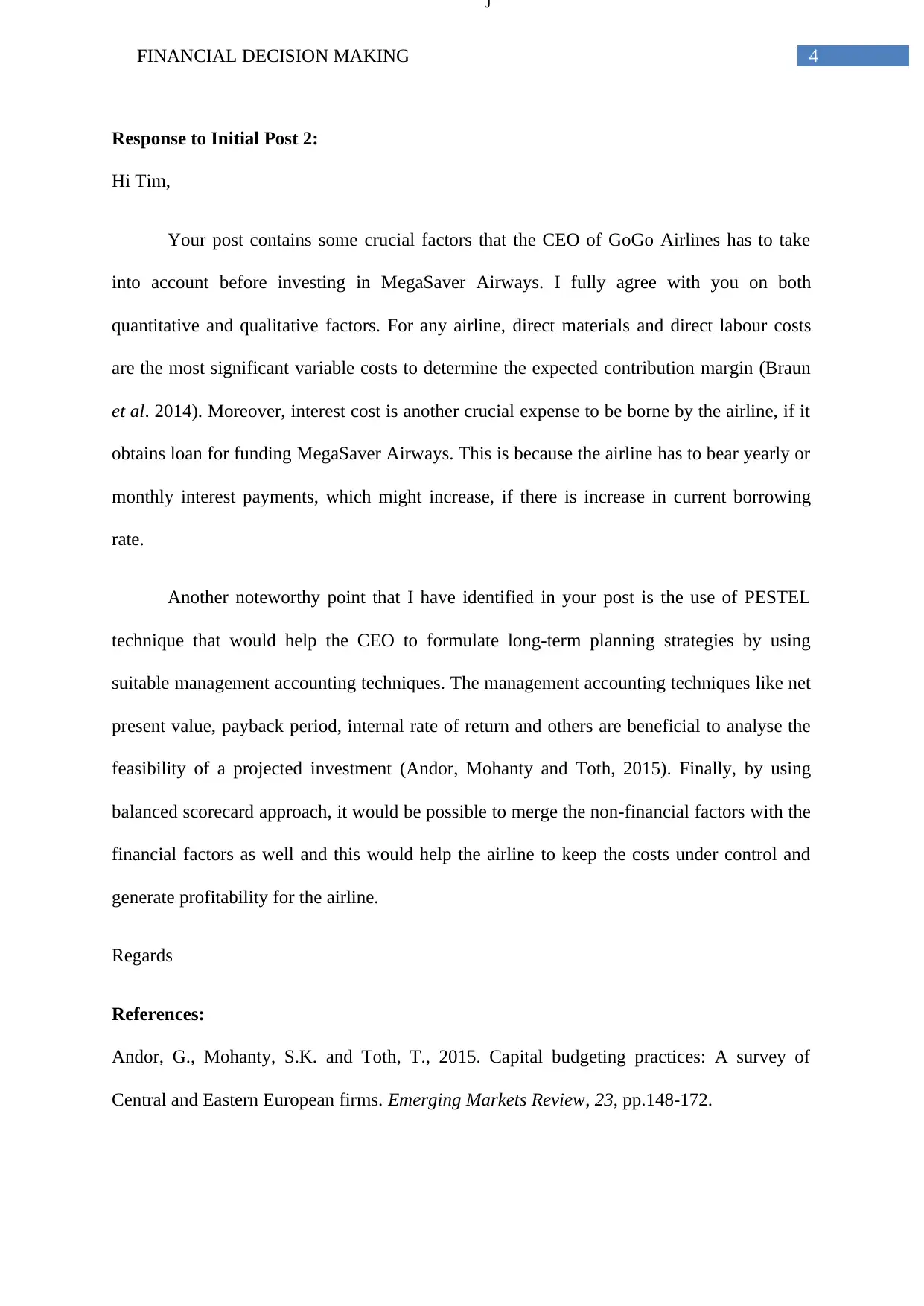
4
j
FINANCIAL DECISION MAKING
Response to Initial Post 2:
Hi Tim,
Your post contains some crucial factors that the CEO of GoGo Airlines has to take
into account before investing in MegaSaver Airways. I fully agree with you on both
quantitative and qualitative factors. For any airline, direct materials and direct labour costs
are the most significant variable costs to determine the expected contribution margin (Braun
et al. 2014). Moreover, interest cost is another crucial expense to be borne by the airline, if it
obtains loan for funding MegaSaver Airways. This is because the airline has to bear yearly or
monthly interest payments, which might increase, if there is increase in current borrowing
rate.
Another noteworthy point that I have identified in your post is the use of PESTEL
technique that would help the CEO to formulate long-term planning strategies by using
suitable management accounting techniques. The management accounting techniques like net
present value, payback period, internal rate of return and others are beneficial to analyse the
feasibility of a projected investment (Andor, Mohanty and Toth, 2015). Finally, by using
balanced scorecard approach, it would be possible to merge the non-financial factors with the
financial factors as well and this would help the airline to keep the costs under control and
generate profitability for the airline.
Regards
References:
Andor, G., Mohanty, S.K. and Toth, T., 2015. Capital budgeting practices: A survey of
Central and Eastern European firms. Emerging Markets Review, 23, pp.148-172.
j
FINANCIAL DECISION MAKING
Response to Initial Post 2:
Hi Tim,
Your post contains some crucial factors that the CEO of GoGo Airlines has to take
into account before investing in MegaSaver Airways. I fully agree with you on both
quantitative and qualitative factors. For any airline, direct materials and direct labour costs
are the most significant variable costs to determine the expected contribution margin (Braun
et al. 2014). Moreover, interest cost is another crucial expense to be borne by the airline, if it
obtains loan for funding MegaSaver Airways. This is because the airline has to bear yearly or
monthly interest payments, which might increase, if there is increase in current borrowing
rate.
Another noteworthy point that I have identified in your post is the use of PESTEL
technique that would help the CEO to formulate long-term planning strategies by using
suitable management accounting techniques. The management accounting techniques like net
present value, payback period, internal rate of return and others are beneficial to analyse the
feasibility of a projected investment (Andor, Mohanty and Toth, 2015). Finally, by using
balanced scorecard approach, it would be possible to merge the non-financial factors with the
financial factors as well and this would help the airline to keep the costs under control and
generate profitability for the airline.
Regards
References:
Andor, G., Mohanty, S.K. and Toth, T., 2015. Capital budgeting practices: A survey of
Central and Eastern European firms. Emerging Markets Review, 23, pp.148-172.

5
j
FINANCIAL DECISION MAKING
Braun, K.W., Tietz, W.M., Harrison, W.T., Bamber, L.S. and Horngren, C.T.,
2014. Managerial accounting. Boston: Pearson.
j
FINANCIAL DECISION MAKING
Braun, K.W., Tietz, W.M., Harrison, W.T., Bamber, L.S. and Horngren, C.T.,
2014. Managerial accounting. Boston: Pearson.
⊘ This is a preview!⊘
Do you want full access?
Subscribe today to unlock all pages.

Trusted by 1+ million students worldwide
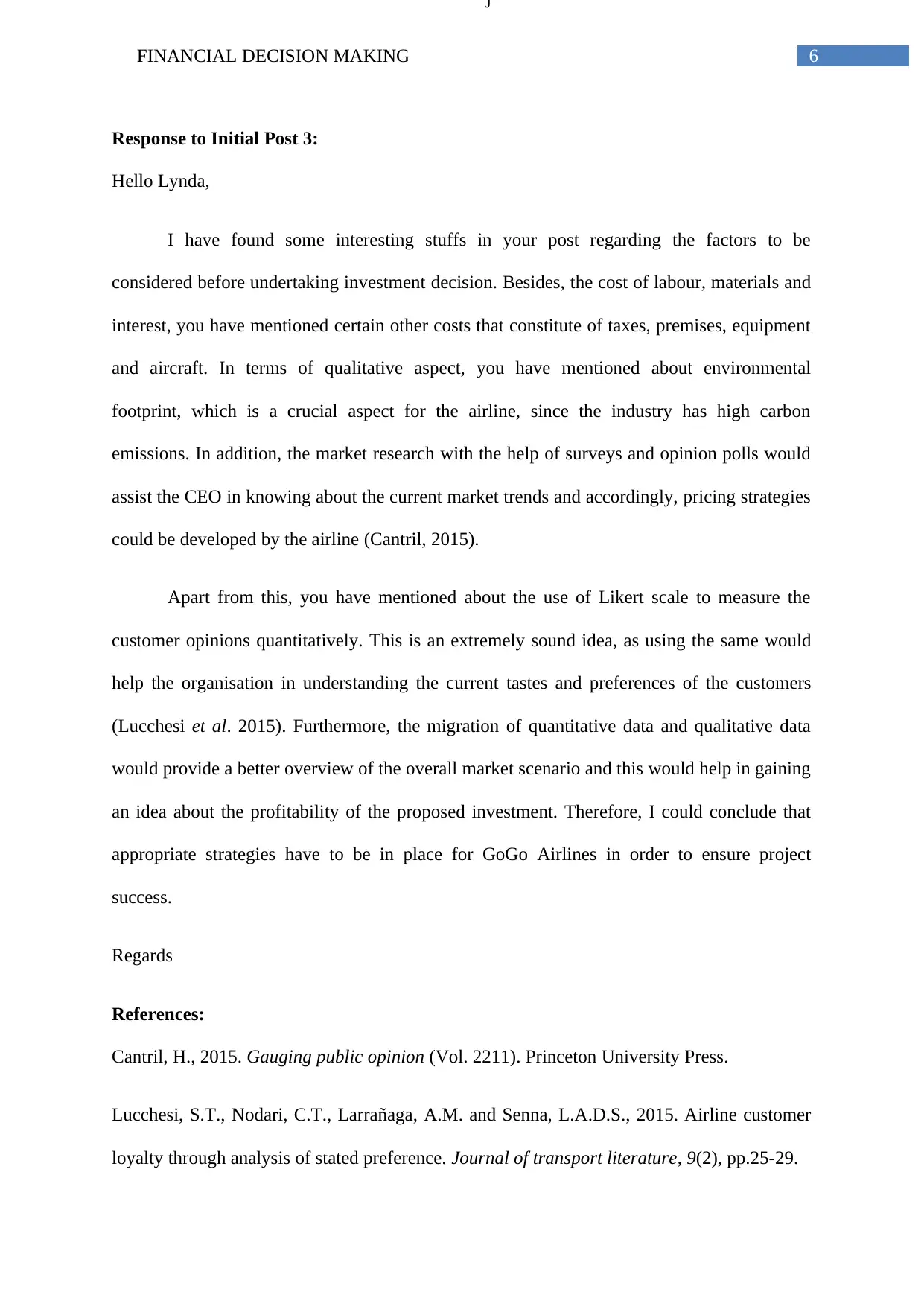
6
j
FINANCIAL DECISION MAKING
Response to Initial Post 3:
Hello Lynda,
I have found some interesting stuffs in your post regarding the factors to be
considered before undertaking investment decision. Besides, the cost of labour, materials and
interest, you have mentioned certain other costs that constitute of taxes, premises, equipment
and aircraft. In terms of qualitative aspect, you have mentioned about environmental
footprint, which is a crucial aspect for the airline, since the industry has high carbon
emissions. In addition, the market research with the help of surveys and opinion polls would
assist the CEO in knowing about the current market trends and accordingly, pricing strategies
could be developed by the airline (Cantril, 2015).
Apart from this, you have mentioned about the use of Likert scale to measure the
customer opinions quantitatively. This is an extremely sound idea, as using the same would
help the organisation in understanding the current tastes and preferences of the customers
(Lucchesi et al. 2015). Furthermore, the migration of quantitative data and qualitative data
would provide a better overview of the overall market scenario and this would help in gaining
an idea about the profitability of the proposed investment. Therefore, I could conclude that
appropriate strategies have to be in place for GoGo Airlines in order to ensure project
success.
Regards
References:
Cantril, H., 2015. Gauging public opinion (Vol. 2211). Princeton University Press.
Lucchesi, S.T., Nodari, C.T., Larrañaga, A.M. and Senna, L.A.D.S., 2015. Airline customer
loyalty through analysis of stated preference. Journal of transport literature, 9(2), pp.25-29.
j
FINANCIAL DECISION MAKING
Response to Initial Post 3:
Hello Lynda,
I have found some interesting stuffs in your post regarding the factors to be
considered before undertaking investment decision. Besides, the cost of labour, materials and
interest, you have mentioned certain other costs that constitute of taxes, premises, equipment
and aircraft. In terms of qualitative aspect, you have mentioned about environmental
footprint, which is a crucial aspect for the airline, since the industry has high carbon
emissions. In addition, the market research with the help of surveys and opinion polls would
assist the CEO in knowing about the current market trends and accordingly, pricing strategies
could be developed by the airline (Cantril, 2015).
Apart from this, you have mentioned about the use of Likert scale to measure the
customer opinions quantitatively. This is an extremely sound idea, as using the same would
help the organisation in understanding the current tastes and preferences of the customers
(Lucchesi et al. 2015). Furthermore, the migration of quantitative data and qualitative data
would provide a better overview of the overall market scenario and this would help in gaining
an idea about the profitability of the proposed investment. Therefore, I could conclude that
appropriate strategies have to be in place for GoGo Airlines in order to ensure project
success.
Regards
References:
Cantril, H., 2015. Gauging public opinion (Vol. 2211). Princeton University Press.
Lucchesi, S.T., Nodari, C.T., Larrañaga, A.M. and Senna, L.A.D.S., 2015. Airline customer
loyalty through analysis of stated preference. Journal of transport literature, 9(2), pp.25-29.
Paraphrase This Document
Need a fresh take? Get an instant paraphrase of this document with our AI Paraphraser
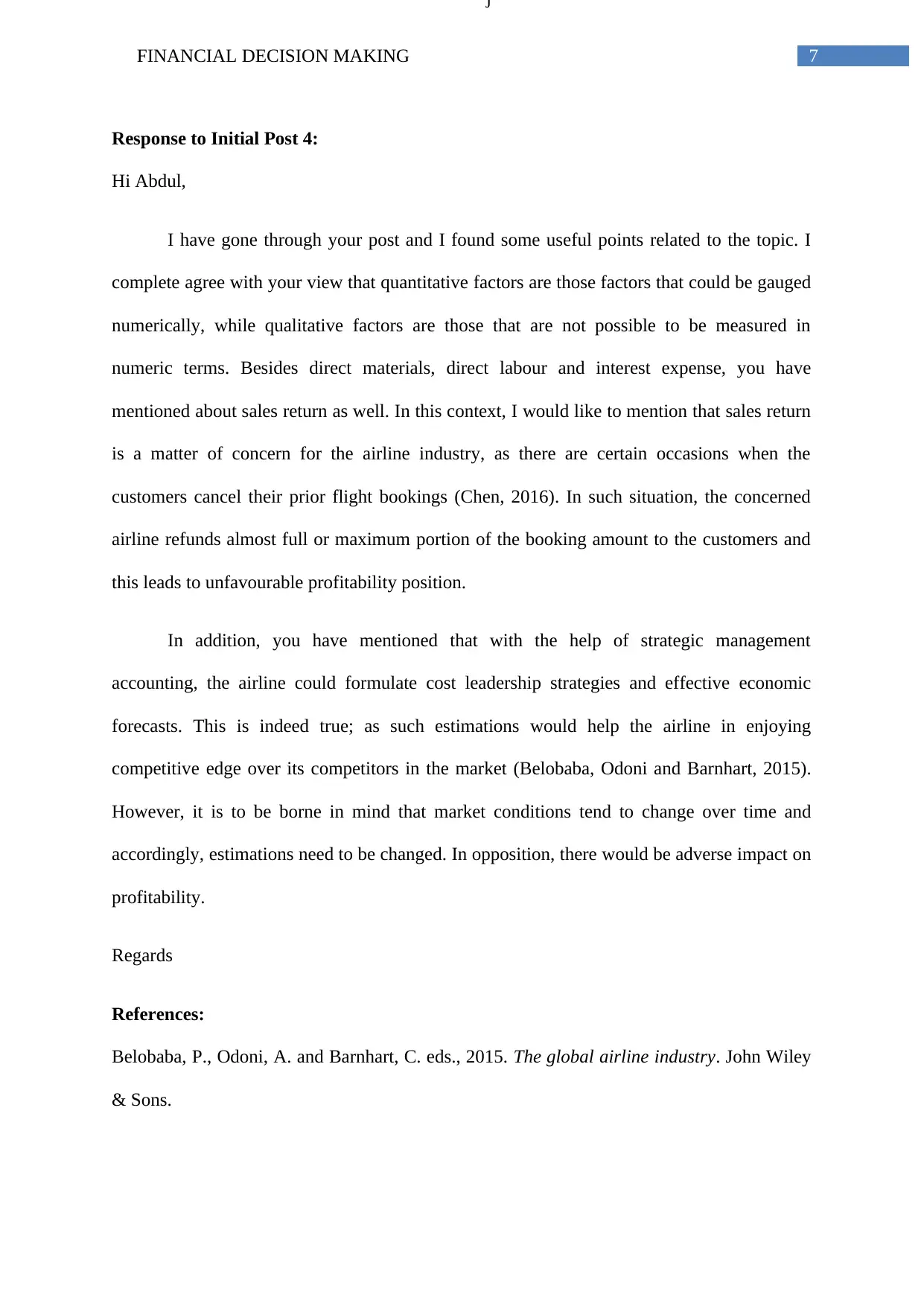
7
j
FINANCIAL DECISION MAKING
Response to Initial Post 4:
Hi Abdul,
I have gone through your post and I found some useful points related to the topic. I
complete agree with your view that quantitative factors are those factors that could be gauged
numerically, while qualitative factors are those that are not possible to be measured in
numeric terms. Besides direct materials, direct labour and interest expense, you have
mentioned about sales return as well. In this context, I would like to mention that sales return
is a matter of concern for the airline industry, as there are certain occasions when the
customers cancel their prior flight bookings (Chen, 2016). In such situation, the concerned
airline refunds almost full or maximum portion of the booking amount to the customers and
this leads to unfavourable profitability position.
In addition, you have mentioned that with the help of strategic management
accounting, the airline could formulate cost leadership strategies and effective economic
forecasts. This is indeed true; as such estimations would help the airline in enjoying
competitive edge over its competitors in the market (Belobaba, Odoni and Barnhart, 2015).
However, it is to be borne in mind that market conditions tend to change over time and
accordingly, estimations need to be changed. In opposition, there would be adverse impact on
profitability.
Regards
References:
Belobaba, P., Odoni, A. and Barnhart, C. eds., 2015. The global airline industry. John Wiley
& Sons.
j
FINANCIAL DECISION MAKING
Response to Initial Post 4:
Hi Abdul,
I have gone through your post and I found some useful points related to the topic. I
complete agree with your view that quantitative factors are those factors that could be gauged
numerically, while qualitative factors are those that are not possible to be measured in
numeric terms. Besides direct materials, direct labour and interest expense, you have
mentioned about sales return as well. In this context, I would like to mention that sales return
is a matter of concern for the airline industry, as there are certain occasions when the
customers cancel their prior flight bookings (Chen, 2016). In such situation, the concerned
airline refunds almost full or maximum portion of the booking amount to the customers and
this leads to unfavourable profitability position.
In addition, you have mentioned that with the help of strategic management
accounting, the airline could formulate cost leadership strategies and effective economic
forecasts. This is indeed true; as such estimations would help the airline in enjoying
competitive edge over its competitors in the market (Belobaba, Odoni and Barnhart, 2015).
However, it is to be borne in mind that market conditions tend to change over time and
accordingly, estimations need to be changed. In opposition, there would be adverse impact on
profitability.
Regards
References:
Belobaba, P., Odoni, A. and Barnhart, C. eds., 2015. The global airline industry. John Wiley
& Sons.

8
j
FINANCIAL DECISION MAKING
Chen, C., 2016. Cancellation policies in the hotel, airline and restaurant industries. Journal of
Revenue and Pricing Management, 15(3-4), pp.270-275.
j
FINANCIAL DECISION MAKING
Chen, C., 2016. Cancellation policies in the hotel, airline and restaurant industries. Journal of
Revenue and Pricing Management, 15(3-4), pp.270-275.
⊘ This is a preview!⊘
Do you want full access?
Subscribe today to unlock all pages.

Trusted by 1+ million students worldwide
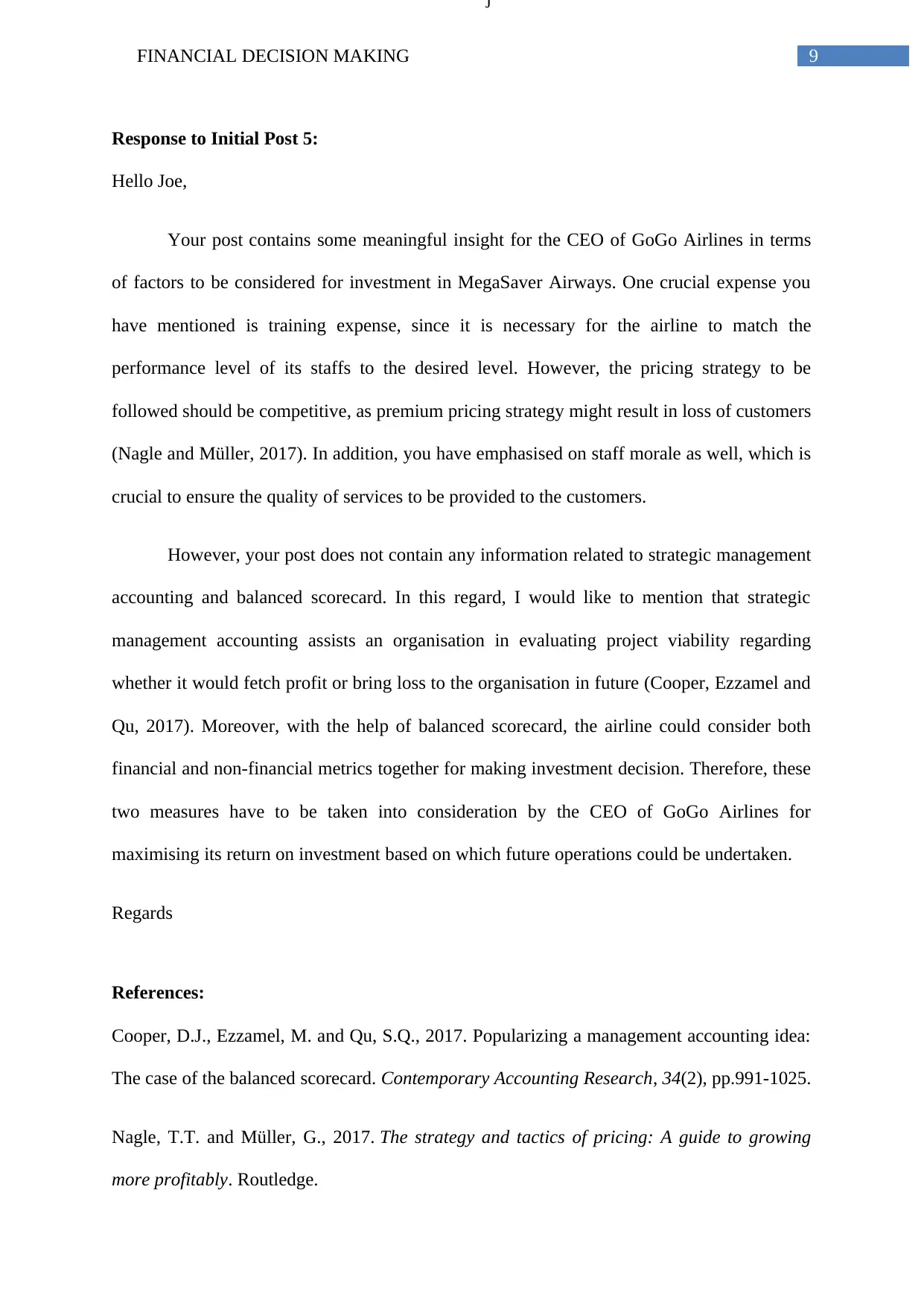
9
j
FINANCIAL DECISION MAKING
Response to Initial Post 5:
Hello Joe,
Your post contains some meaningful insight for the CEO of GoGo Airlines in terms
of factors to be considered for investment in MegaSaver Airways. One crucial expense you
have mentioned is training expense, since it is necessary for the airline to match the
performance level of its staffs to the desired level. However, the pricing strategy to be
followed should be competitive, as premium pricing strategy might result in loss of customers
(Nagle and Müller, 2017). In addition, you have emphasised on staff morale as well, which is
crucial to ensure the quality of services to be provided to the customers.
However, your post does not contain any information related to strategic management
accounting and balanced scorecard. In this regard, I would like to mention that strategic
management accounting assists an organisation in evaluating project viability regarding
whether it would fetch profit or bring loss to the organisation in future (Cooper, Ezzamel and
Qu, 2017). Moreover, with the help of balanced scorecard, the airline could consider both
financial and non-financial metrics together for making investment decision. Therefore, these
two measures have to be taken into consideration by the CEO of GoGo Airlines for
maximising its return on investment based on which future operations could be undertaken.
Regards
References:
Cooper, D.J., Ezzamel, M. and Qu, S.Q., 2017. Popularizing a management accounting idea:
The case of the balanced scorecard. Contemporary Accounting Research, 34(2), pp.991-1025.
Nagle, T.T. and Müller, G., 2017. The strategy and tactics of pricing: A guide to growing
more profitably. Routledge.
j
FINANCIAL DECISION MAKING
Response to Initial Post 5:
Hello Joe,
Your post contains some meaningful insight for the CEO of GoGo Airlines in terms
of factors to be considered for investment in MegaSaver Airways. One crucial expense you
have mentioned is training expense, since it is necessary for the airline to match the
performance level of its staffs to the desired level. However, the pricing strategy to be
followed should be competitive, as premium pricing strategy might result in loss of customers
(Nagle and Müller, 2017). In addition, you have emphasised on staff morale as well, which is
crucial to ensure the quality of services to be provided to the customers.
However, your post does not contain any information related to strategic management
accounting and balanced scorecard. In this regard, I would like to mention that strategic
management accounting assists an organisation in evaluating project viability regarding
whether it would fetch profit or bring loss to the organisation in future (Cooper, Ezzamel and
Qu, 2017). Moreover, with the help of balanced scorecard, the airline could consider both
financial and non-financial metrics together for making investment decision. Therefore, these
two measures have to be taken into consideration by the CEO of GoGo Airlines for
maximising its return on investment based on which future operations could be undertaken.
Regards
References:
Cooper, D.J., Ezzamel, M. and Qu, S.Q., 2017. Popularizing a management accounting idea:
The case of the balanced scorecard. Contemporary Accounting Research, 34(2), pp.991-1025.
Nagle, T.T. and Müller, G., 2017. The strategy and tactics of pricing: A guide to growing
more profitably. Routledge.
Paraphrase This Document
Need a fresh take? Get an instant paraphrase of this document with our AI Paraphraser
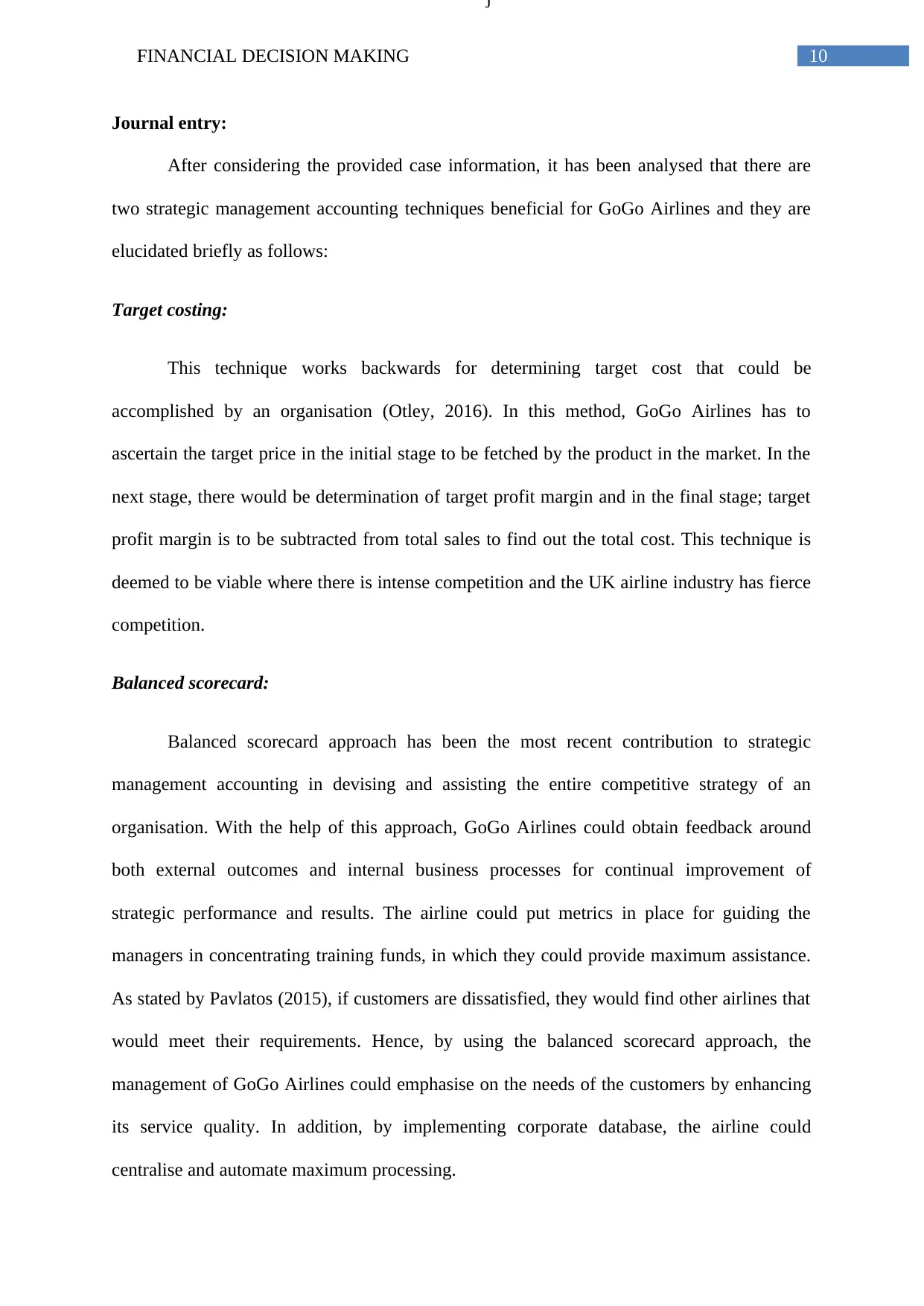
10
j
FINANCIAL DECISION MAKING
Journal entry:
After considering the provided case information, it has been analysed that there are
two strategic management accounting techniques beneficial for GoGo Airlines and they are
elucidated briefly as follows:
Target costing:
This technique works backwards for determining target cost that could be
accomplished by an organisation (Otley, 2016). In this method, GoGo Airlines has to
ascertain the target price in the initial stage to be fetched by the product in the market. In the
next stage, there would be determination of target profit margin and in the final stage; target
profit margin is to be subtracted from total sales to find out the total cost. This technique is
deemed to be viable where there is intense competition and the UK airline industry has fierce
competition.
Balanced scorecard:
Balanced scorecard approach has been the most recent contribution to strategic
management accounting in devising and assisting the entire competitive strategy of an
organisation. With the help of this approach, GoGo Airlines could obtain feedback around
both external outcomes and internal business processes for continual improvement of
strategic performance and results. The airline could put metrics in place for guiding the
managers in concentrating training funds, in which they could provide maximum assistance.
As stated by Pavlatos (2015), if customers are dissatisfied, they would find other airlines that
would meet their requirements. Hence, by using the balanced scorecard approach, the
management of GoGo Airlines could emphasise on the needs of the customers by enhancing
its service quality. In addition, by implementing corporate database, the airline could
centralise and automate maximum processing.
j
FINANCIAL DECISION MAKING
Journal entry:
After considering the provided case information, it has been analysed that there are
two strategic management accounting techniques beneficial for GoGo Airlines and they are
elucidated briefly as follows:
Target costing:
This technique works backwards for determining target cost that could be
accomplished by an organisation (Otley, 2016). In this method, GoGo Airlines has to
ascertain the target price in the initial stage to be fetched by the product in the market. In the
next stage, there would be determination of target profit margin and in the final stage; target
profit margin is to be subtracted from total sales to find out the total cost. This technique is
deemed to be viable where there is intense competition and the UK airline industry has fierce
competition.
Balanced scorecard:
Balanced scorecard approach has been the most recent contribution to strategic
management accounting in devising and assisting the entire competitive strategy of an
organisation. With the help of this approach, GoGo Airlines could obtain feedback around
both external outcomes and internal business processes for continual improvement of
strategic performance and results. The airline could put metrics in place for guiding the
managers in concentrating training funds, in which they could provide maximum assistance.
As stated by Pavlatos (2015), if customers are dissatisfied, they would find other airlines that
would meet their requirements. Hence, by using the balanced scorecard approach, the
management of GoGo Airlines could emphasise on the needs of the customers by enhancing
its service quality. In addition, by implementing corporate database, the airline could
centralise and automate maximum processing.
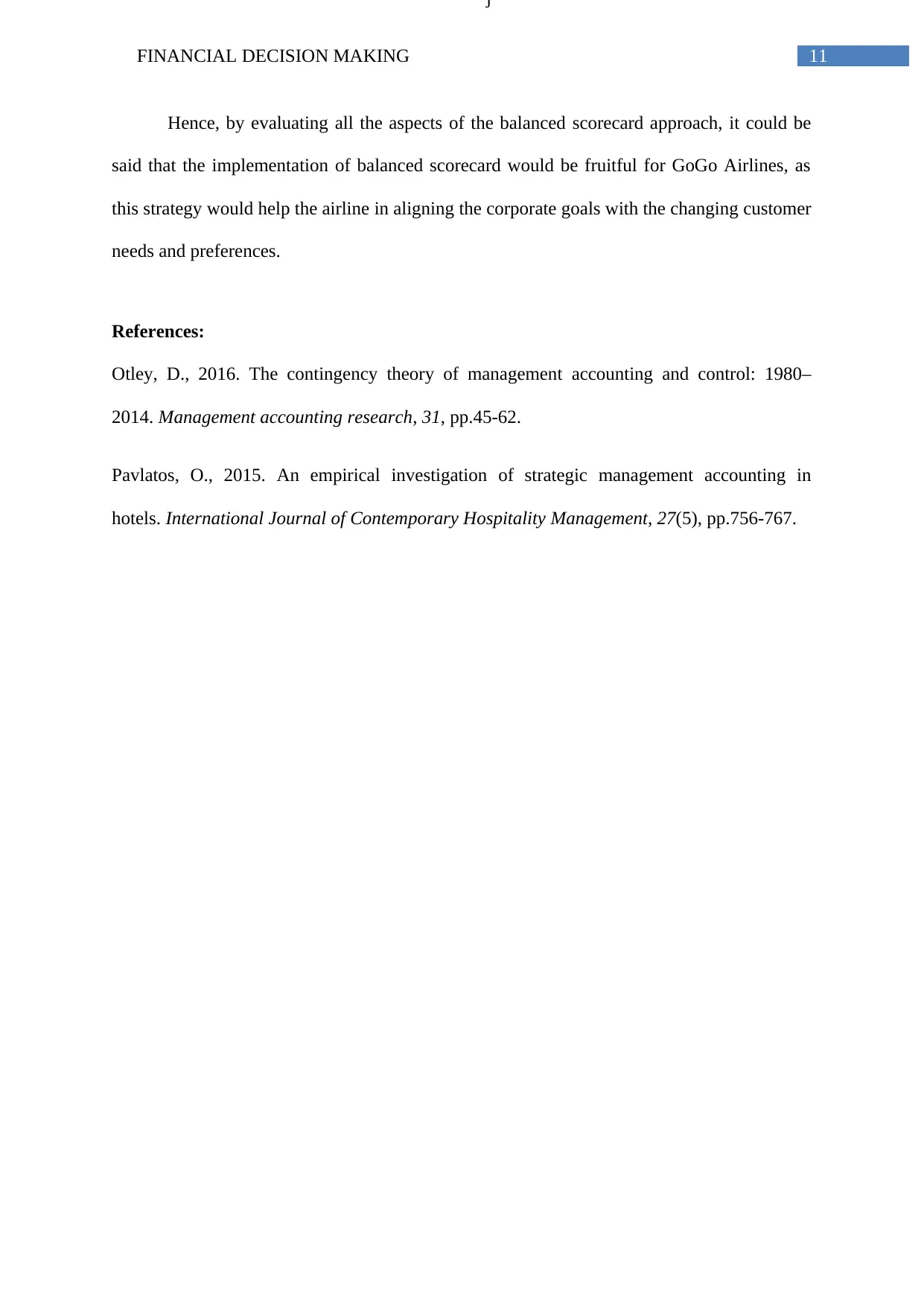
11
j
FINANCIAL DECISION MAKING
Hence, by evaluating all the aspects of the balanced scorecard approach, it could be
said that the implementation of balanced scorecard would be fruitful for GoGo Airlines, as
this strategy would help the airline in aligning the corporate goals with the changing customer
needs and preferences.
References:
Otley, D., 2016. The contingency theory of management accounting and control: 1980–
2014. Management accounting research, 31, pp.45-62.
Pavlatos, O., 2015. An empirical investigation of strategic management accounting in
hotels. International Journal of Contemporary Hospitality Management, 27(5), pp.756-767.
j
FINANCIAL DECISION MAKING
Hence, by evaluating all the aspects of the balanced scorecard approach, it could be
said that the implementation of balanced scorecard would be fruitful for GoGo Airlines, as
this strategy would help the airline in aligning the corporate goals with the changing customer
needs and preferences.
References:
Otley, D., 2016. The contingency theory of management accounting and control: 1980–
2014. Management accounting research, 31, pp.45-62.
Pavlatos, O., 2015. An empirical investigation of strategic management accounting in
hotels. International Journal of Contemporary Hospitality Management, 27(5), pp.756-767.
⊘ This is a preview!⊘
Do you want full access?
Subscribe today to unlock all pages.

Trusted by 1+ million students worldwide
1 out of 12
Related Documents
Your All-in-One AI-Powered Toolkit for Academic Success.
+13062052269
info@desklib.com
Available 24*7 on WhatsApp / Email
![[object Object]](/_next/static/media/star-bottom.7253800d.svg)
Unlock your academic potential
Copyright © 2020–2025 A2Z Services. All Rights Reserved. Developed and managed by ZUCOL.


